Text

🎞Bienvenue sur notre chaîne YouTube🎞
2 notes
·
View notes
Photo

⚜️GS⚜️
Parts of an armour.
Unknown Artist / Maker.
South Germany, probably Augsburg.
Date: c. 1550.
Medium: Steel, copper alloy, leather and gold, embossed, etched and gilt.
🏛The Wallace Collection.
@wallacemuseum
~•~
📝This group of objects comprises portions of a large garniture made, probably in Augsburg, for a member of the Hürnheim family, probably Hans Walther von Hürnheim (d. 1557), a prominent Swabian nobleman who served both in the government of the Emperor Charles V and as mercenary captain. He is known to have had ten thousand Landsknechte under his command, fought on the Imperial side at the Battle of Mühlberg (1547) and led mercenary forces in many other campaigns in the service of the Empire. He was also a member of the order of the Knights of the Golden Spur, a chivalric brotherhood made up of elite Imperial officers. The Hürnheim connection is confirmed by the family’s coat of arms displayed on the shaffron escutcheon: a pair of golden stag’s antlers on a red field.
The complete armour was originally comprised of a field harness which could be configured for different forms of combat using a set of exchange pieces for field, joust, and tournament. Some of these ‘double pieces’ make up the Wallace Collection group, composed of a light burgonet and left pauldron for the field, a left gauntlet, a right demi-cuisse, a pair of partial greaves, the reinforcing bevor, grandguard, reinforcing breastplate, tasset and gauntlet reinforce for the German joust in the ‘Italian’ fashion (Welschgestech), a manifer for one of the jousts in the German fashion, probably some form of Rennen or ‘joust of war’ and a half-shaffron. The essential field armour portions of this elegant garniture are today in the collection of the Royal Armouries, Leeds (inv. II.187). In the 1950s the field armour, then at the Tower of London, was brought together with the Wallace Collection pieces, so that the garniture’s Italian joust configuration could be recreated.
~•~
📸6️⃣6️⃣📸 Facebook ⚜️GS⚜️
~•~
📌#london #augsburg #germany #armour #museum #art (à The Wallace Collection)
https://www.instagram.com/p/CPVkT0un6zs/?utm_medium=tumblr
22 notes
·
View notes
Photo
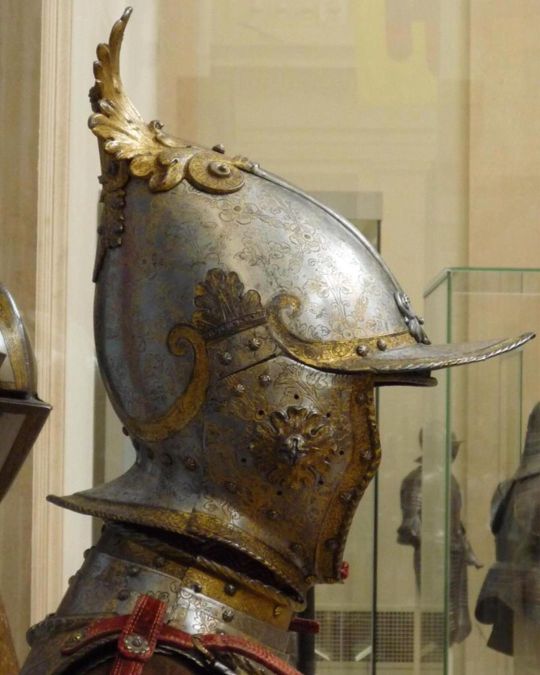
⚜️GS⚜️
Armor of Giovanni Battista Bourbon del Monte (1541–1614).
Date: ca. 1590.
Culture: Italian, possibly Brescia.
Medium: Steel, gold, textile, leather.
Dimensions: Wt. of helmet 4 lb. 12 oz. (2155 g).
Accession Number: 14.25.710a–f.
~•~
The Metropolitan Museum of Art.
@metarmsandarmor
~•~
📝Del Monte (1541–1614) was a mercenary soldier who at various times served the emperor, the pope, the kings of Spain and France, and the Venetian Republic. This armor dates from the period of del Monte’s service to Venice as captain-general of infantry. It probably was made in Brescia, an armor-making center then under Venetian control.
The armor is notable for its elegantly pointed helmet with a steel plume and for the etched and gilt decoration in imitation of a textile pattern. Overall decoration of this kind was especially fashionable in the period from 1590 to 1610.
A portrait of del Monte in the Museo Stibbert, Florence, shows this armor with its shoulder pieces, arms and gauntlets, now missing.
Two glaives bearing the del Monte coat of arms are also in the Metropolitan Museum’s collection (acc. nos. 04.3.88, .89). Originally, they would have been carried by the captain-general’s personal guards.
~•~
🤝Merci beaucoup pour les photos T. Hoog.
~•~
💥1️⃣8️⃣💥photos de cette armure sur notre page Facebook!
~•~
📌#usa #france #spain #veneci #armour #museum #art (à The Metropolitan Museum of Art, New York)
https://www.instagram.com/p/CPTlvp3HlO5/?utm_medium=tumblr
32 notes
·
View notes
Text

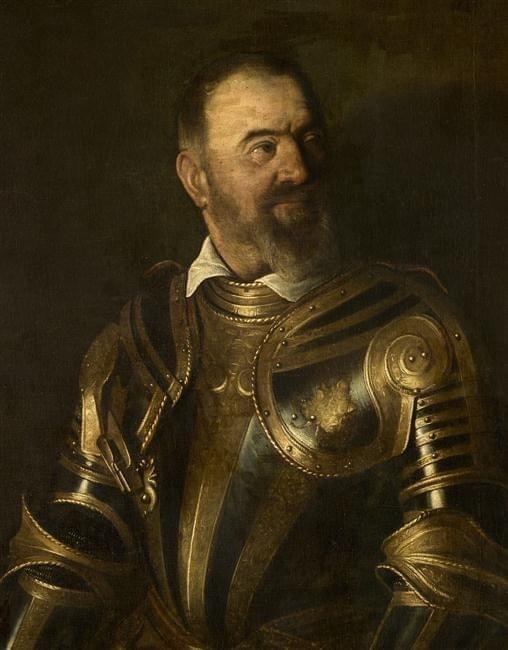

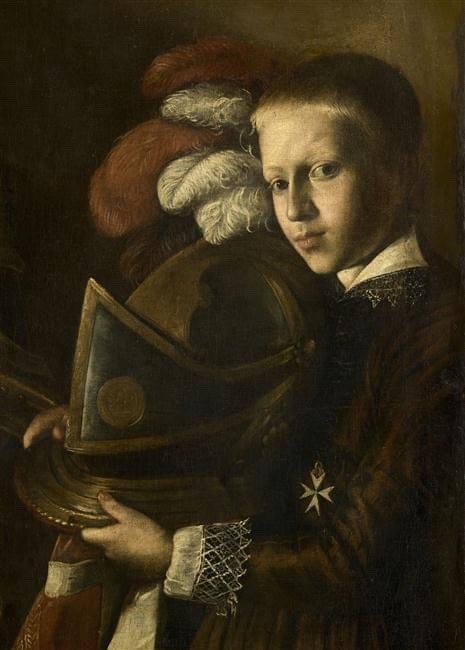
Le Caravage (dit), Merisi da Caravaggio Michelangelo (vers).
Alof de Wignacourt (1547-1622), Grand maître de l'ordre de Malte de 1601 à 1622, et son page.
Date: 1608.
Dimensions:
Hauteur 1.94 m.
Largeur 1.34 m.
Période:
16e siècle, 17e siècle, Europe (période) - période moderne.
Paris, musée du Louvre.
14 notes
·
View notes
Text
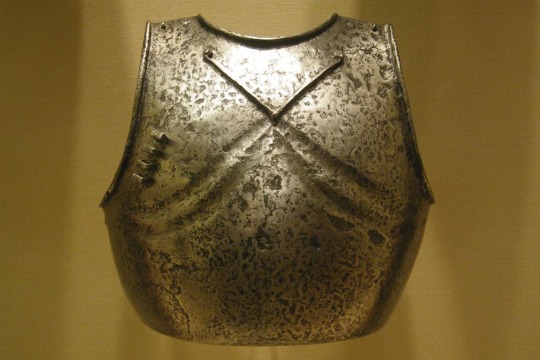
Breastplate with applied stop-rib.
Date: ca. 1420–40.
Culture: Italian.
Medium: Steel.
The Metropolitan Museum of Art.
This early example of a one-piece breastplate comes from a large horde of armor from the fortress of the knights of the Order of Saint John of Jerusalem on the Mediterranean island of Rhodes, which fell to the Turks in 1522. The V-shaped stop rib served to deflect the points of weapons away from the neck.
34 notes
·
View notes
Photo
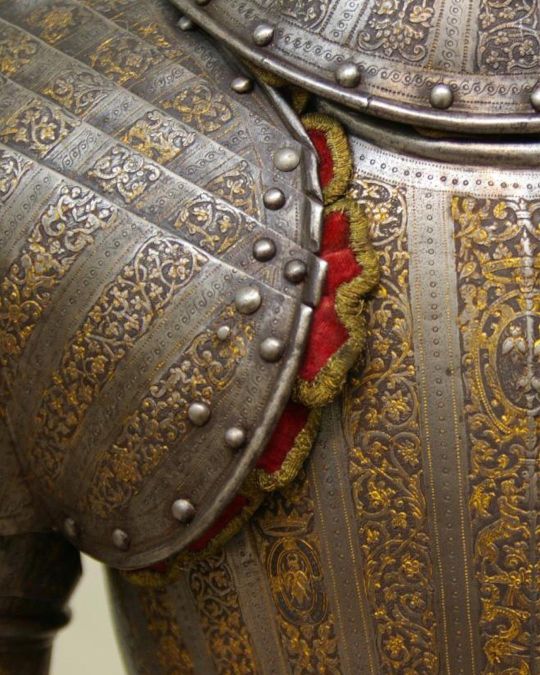
⚜️GS⚜️
💥Part I.
⚔️Armor for a Member of the Barberini Family.
• Date: armor, ca. 1623–30; spurs, early 17th century.
• Culture: armor, Italian, Milan; spurs, French.
• Medium: Steel, gold, silver, brass, textile, leather.
⚖️Dimensions:
Armor (26.210a–m): Wt. 34 lb. 8 oz. (15.65 kg); Wt. of helmet 5 lb. 3 oz. (2350 g); spurs (14.25.1731a, b): L. of each neck 1 ¼ in. (3.2 cm); L. of each rowel box 1 3/8 in. (3.5 cm); Diam. of each star rowel 2 1/8 in. (5.4 cm); Wt. of left spur 5 lb. 4 oz. (2381 g); Wt. of right spur 5 lb. 8 oz. (2495 g).
• Accession Number: 26.210a–m; 14.25.1731a, b.
~•~
🏛The Metropolitan Museum of Art.
@metarmsandarmor
~•~
📝This armor is a deluxe version of a typical cuirassier’s armor, worn by heavy cavalry armed with sword and pistols. Its rich ornament and light weight, however, indicate that it was designed primarily for ceremonial wear and as a symbol of martial status.
The punched and chiseled decoration is characteristic of elaborate Milanese armor of the early seventeenth century. The designs include numerous crowned ovals enclosing bees, the badge of the Barberini, one of Rome’s most powerful families. The Barberini rose to prominence, wealth, and power with the election of Maffeo Barberini as Pope Urban VIII in 1623. Presumably, this armor was made for the ranking secular member of the family, either Carlo (1562–1630) or his son Tadeo (1603–1647). The pope’s brother, Carlo was general of the papal armies and duke of Monterotondo from 1623 and prince of Palestrina from 1629. Taddeo succeeded to his father’s titles and offices in 1630.
~•~
🤝 Merci pour les photos T. Hoog.
~•~
📌#usa #french #italian #milan #museum #armour #art (à The Metropolitan Museum of Art, New York)
https://www.instagram.com/p/CPFno-Jniex/?utm_medium=tumblr
58 notes
·
View notes
Photo

⚜️GS⚜️
Gauntlet for the Right Hand, Belonging to the Armor of Don Alonzo Pérez de Guzman el Bueno (1550–1619), Count of Niebla and Duke of Medina-Sidonia.
Date: ca. 1580.
Culture: Italian, Milan.
Medium: Steel, silver, gold, textile, leather.
Dimensions: L. 13 in. (33 cm); W. 5 9/16 in. (14.2 cm); H. 6 ¼ in. (16.2 cm); Wt. 25 oz. (707 g).
Accession Number: 2002.507.
~•~
🏛The Metropolitan Museum of Art.
@metarmsandarmor
~•~
📝The gauntlet’s elaborately chiseled and damascened decoration exemplifies the highest quality of late Renaissance Milanese metalworking. The owner’s crowned monogram on the cuff identifies the gauntlet as belonging to the armor of Don Alonzo Pérez de Guzman el Bueno (1550–1619), count of Niebla and duke of Medina-Sidonia, the commander of the ill-fated armada sent against England in 1588. The rest of the duke’s armor, a heavy bulletproof harness that was practical despite its rich decoration, is preserved in the Royal Armory, Madrid.
~•~
📌#usa #italian #milan #armour #artmetal #chevalier (à The Metropolitan Museum of Art, New York)
https://www.instagram.com/p/CPFmpFHndjp/?utm_medium=tumblr
23 notes
·
View notes
Photo

⚜️GS⚜️
Tapisserie dite du Tournoi.
15e siècle, période médiévale - Bas Moyen Âge.
Bruxelles (origine), Flandres (région historique) (origine).
Technique/Matière:
laine (textile) ,soie (textile), tapisserie (technique).
🏛Valenciennes, musée des Beaux-Arts.
@mba_valenciennes
~•~
📝Fin 15e siècle. Tournoi organisé à Anvers lors de l'intronisation de Philippe le Beau comme gouverneur des Pays-Bas (?).
~•~
#france #art #musée #chevalier #armure (à Musée des beaux-arts de Valenciennes)
https://www.instagram.com/p/CPFlBuvnVm9/?utm_medium=tumblr
24 notes
·
View notes
Photo
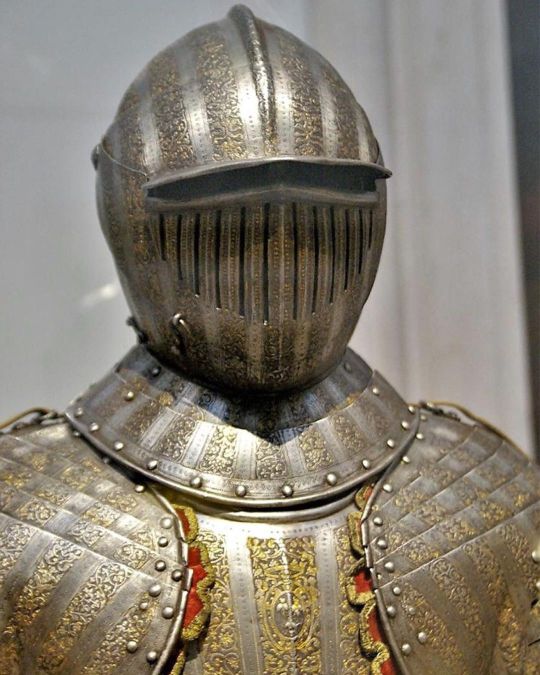
⚜️GS⚜️
💥 Part II.
Armor for a Member of the Barberini Family.
• Date: armor, ca. 1623–30; spurs, early 17th century.
• Culture: armor, Italian, Milan; spurs, French.
• Medium: Steel, gold, silver, brass, textile, leather.
⚖️ Dimensions:
Armor (26.210a–m): Wt. 34 lb. 8 oz. (15.65 kg); Wt. of helmet 5 lb. 3 oz. (2350 g); spurs (14.25.1731a, b): L. of each neck 1 ¼ in. (3.2 cm); L. of each rowel box 1 3/8 in. (3.5 cm); Diam. of each star rowel 2 1/8 in. (5.4 cm); Wt. of left spur 5 lb. 4 oz. (2381 g); Wt. of right spur 5 lb. 8 oz. (2495 g).
Accession Number: 26.210a–m; 14.25.1731a, b.
🏛The Metropolitan Museum of Art.
@metarmsandarmor
~•~
📝 This armor is a deluxe version of a typical cuirassier’s armor, worn by heavy cavalry armed with sword and pistols. Its rich ornament and light weight, however, indicate that it was designed primarily for ceremonial wear and as a symbol of martial status.
The punched and chiseled decoration is characteristic of elaborate Milanese armor of the early seventeenth century. The designs include numerous crowned ovals enclosing bees, the badge of the Barberini, one of Rome’s most powerful families. The Barberini rose to prominence, wealth, and power with the election of Maffeo Barberini as Pope Urban VIII in 1623. Presumably, this armor was made for the ranking secular member of the family, either Carlo (1562–1630) or his son Tadeo (1603–1647). The pope’s brother, Carlo was general of the papal armies and duke of Monterotondo from 1623 and prince of Palestrina from 1629. Taddeo succeeded to his father’s titles and offices in 1630.
~•~
🤝 Merci beaucoup pour les photos T. Hoog.
~•~
📌#usa #museum #armour #knight #metalart #chevalier (at The Metropolitan Museum of Art, New York)
https://www.instagram.com/p/CPEeyV8HVUw/?utm_medium=tumblr
92 notes
·
View notes
Text
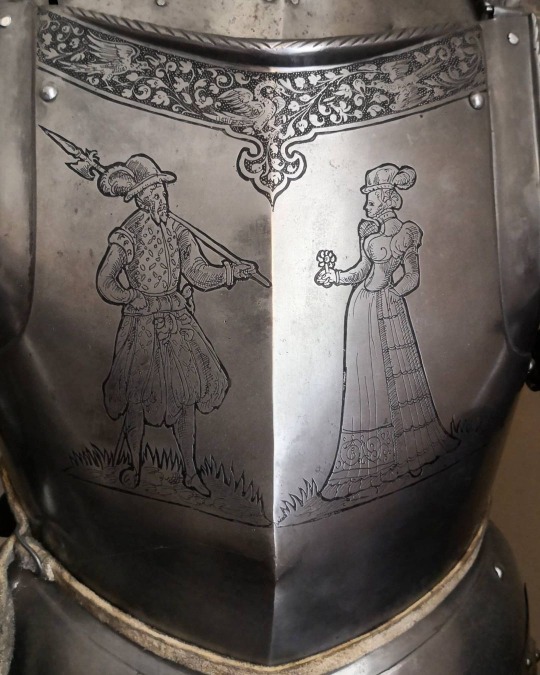
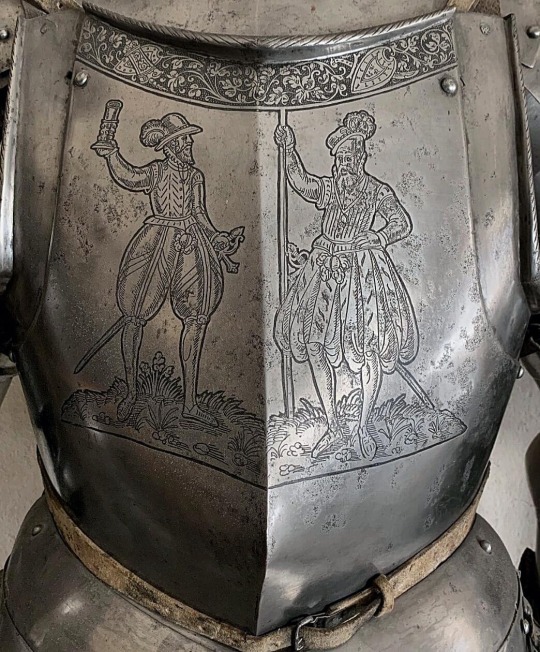
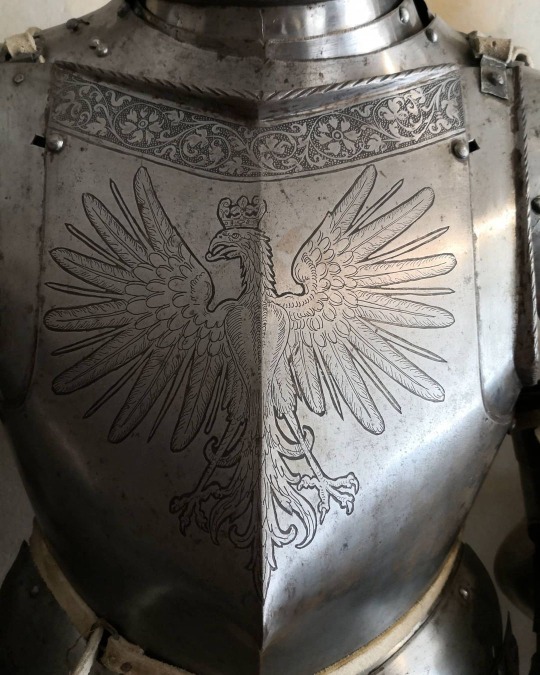


Landsknecht armors made in Augsburg in Bavaria between 1550 and 1560.
In the Churburg Castle we‘ll find eight armors made in this same style. Every single armor is decorated with a different, tipical scenes on the breastplate, such as biblical representations or the Tyrolean eagle.
117 notes
·
View notes
Text

Chevalier galopant.
Dürer Albrecht (1471-1528), peintre, dessinateur et graveur.
Vers 1485/1500.
Technique/Matière:
Dessin à la pointe d'argent, encre brune, encre grise,papier préparé blanc.
Dimensions:
Hauteur 0.151 m.
Largeur 0.165 m.
Allemagne, Berlin, Kupferstichkabinett (SMPK).
33 notes
·
View notes
Text


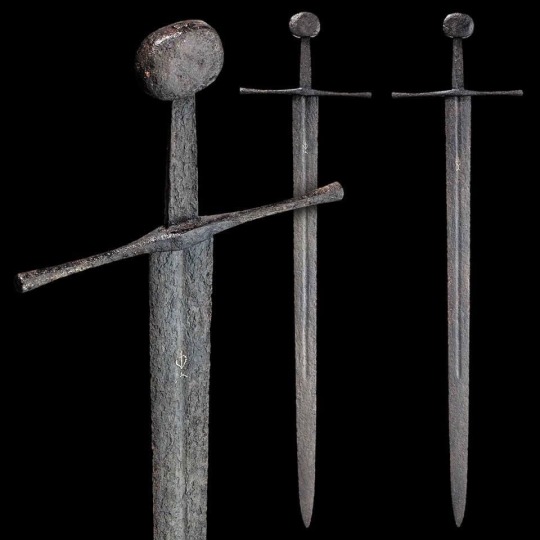

1.📸 14th Century Swords, left to right:
Riding Sword, English, circa 1325.
Found in the River Nene, this sword is heavily corroded. Rounded pommel covered in a copper alloy, decorated with a raised shield and an incised coat of arms. Likely a so-called “riding sword”; smaller and lighter than war swords.
Overall length: 80 cm (31.5").
Riding Sword, circa 1380.
Globular pommel with pronounced tang button. Downward-curving cross-guard was common in medieval France and Germany. The shorter blade may classify this as a “riding sword”; used for civilian purposes such as the hunt or for court.
Overall length: 90 cm (35.4").
Knightly Sword, circa 1300-1325.
Wide, double-edged blade with single narrow fuller. Short, straight cross-guard is of squared cross-section. Grip is a later replacement.
Overall length: 96.5 cm (38").
Knightly Sword, English, circa 1300-1400.
Very large rounded pommel; short, slightly flared cross-guard; double-edged blade with sharp point suitable for thrusting.
Overall length: 81.5 cm (32.6").
2.📸 Sword, circa 1380.
Triangular pommel with flat planes and a curved top. The straight cross-guard, round in section, thickens in the center. The blade is double-edged and flat with a maker’s mark In copper 18.5 cm (7.28") from the hilt.
Blade length: 79 cm (31.1"); Blade width: 3.5 cm (1.38"); Weight: 0.945 kg (2.08 pounds).
Wallace Collection A.464.
3.📸 A German Knightly Sword, 1st half of the 14th century.
Double-edged blade with a narrow fuller on both sides. Cross-guard of circular section slightly widening at the ends. Conical tang with round disc pommel.
Overall length: 105 cm (41.34").
Copyright © Hermann Historica Auction House.
4.📸 Hand-and-a-half sword, German, 2nd half of the 14th century.
Double-edged blade with shallow fuller. Straight cross-guard of squared section with chamfered edges. Slightly tapered tang with a large octagonal pommel, its faces inlaid with silver—a cross potent on one side, a coat of arms on the other. Cleaned and conserved state.
Overall length: 115 cm (45.28").
Provenance: Private Collection Hessian.
Copyright © Hermann Historica Auction House.
99 notes
·
View notes
Photo

⚜️GS⚜️
Cuirassier’s Armor.
Date: dated 1621; helmet brim and buffe, 19th century.
Culture: possibly Dutch.
Medium: Steel, gold, leather.
Dimensions: Wt. 80 lb. 6 oz. (36.45 kg).
~•~
🏛The Metropolitan Museum of Art.
@metarmsandarmor
~•~
📝This armor appears to belong to a small group of finely made Dutch armors from the first third of the seventeenth century. The date is found in the decoration of the lowest plates of the poleyns (knee defenses) and reads, ANNO (left); 1621 (right). The helmet’s brim and falling buffe (face defense) are restorations dating from the nineteenth century. Both the breastplate and backplate of this armor were proved, that is, a pistol or musket was fired at them to ensure that they were bulletproof. The resulting dent was then hammered out to leave only a slight depression, which was incorporated into the decoration.
~•~
Photos credit: T. Hoog.
📌#usa #museum #armour #medieal #knight #metalartist (à The Metropolitan Museum of Art, New York)
https://www.instagram.com/p/CO8cTMrHr3G/?igshid=17eg1un8n366r
26 notes
·
View notes
Text

Painter, graphic artist, illustrator Caspar Johann Nepomuk Scheuren (1810-1887).
"The knight at the blacksmith".
112 notes
·
View notes
Text

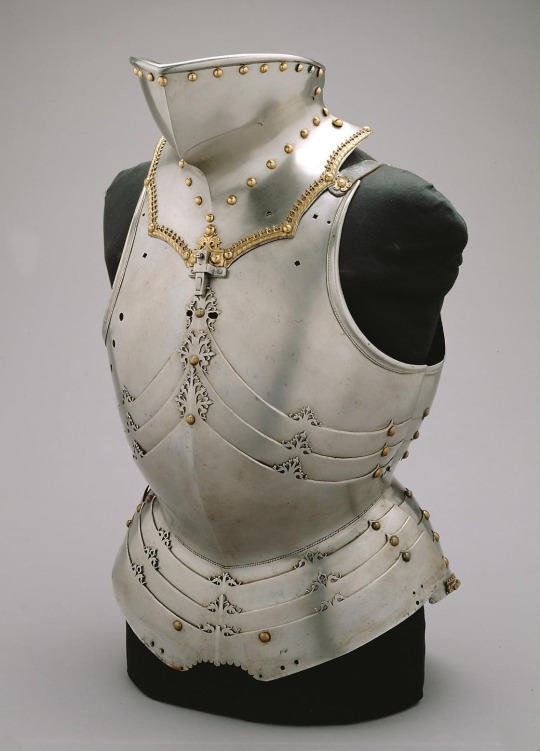
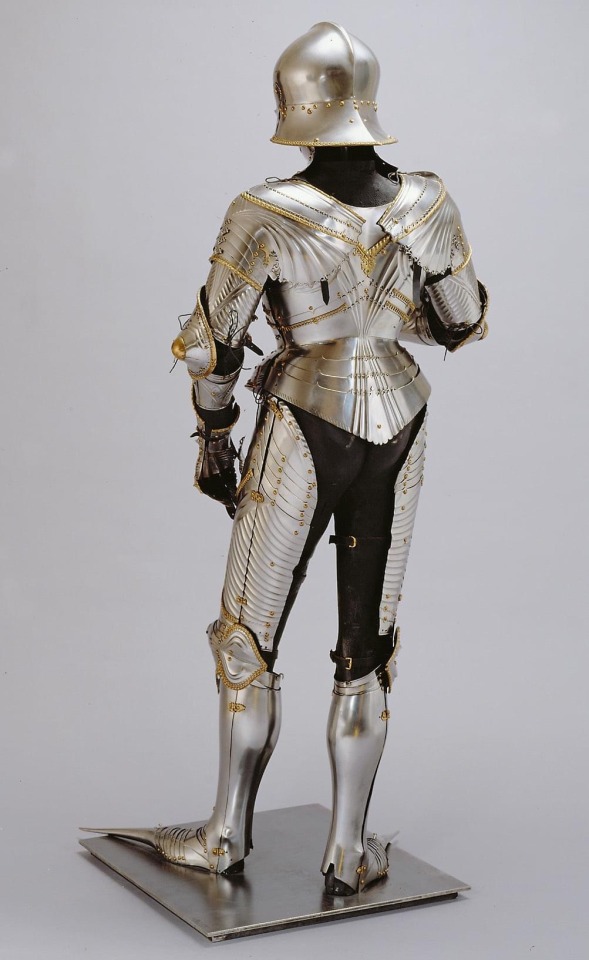

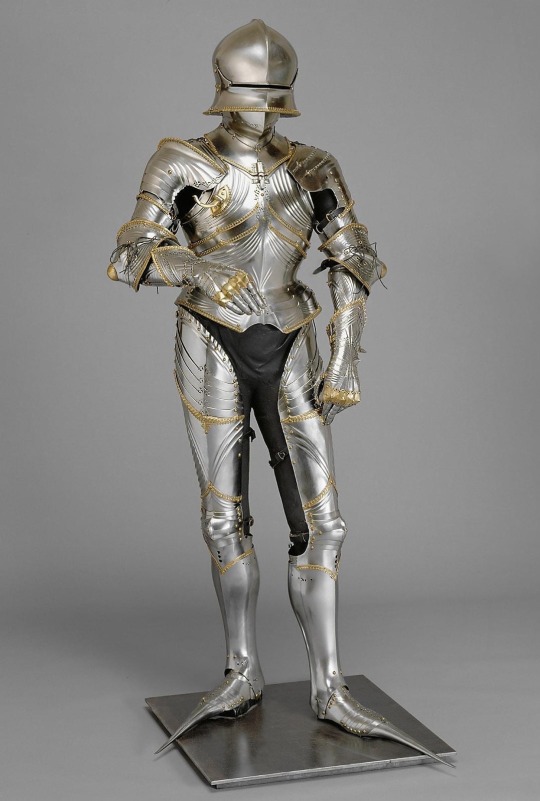
Field Armor of Maximilian I.
Lorenz Helmschmid (German, Augsburg, ca. 1445–1516).
Date: 1479–80.
Culture: South German, Augsburg.
Medium: Steel, copper alloy, leather
Dimensions:
H. 70 5/8 in. (179.5 cm).
W. 29 7/8 in. (76 cm).
D. 27 in. (68.5 cm).
Kunsthistorisches Museum Wien, Hofjagd- und Rüstkammer.
Lorenz Helmschmid does not normally work for Sigmund von Tirol, the owner of this armor, but primarily for Emperor Maximilian I, whose armor orders can be partially reconstructed from the so-called Thunian sketchbook. This armor was probably also ordered by Maximilian. He probably wore it as a young prince and later gave it to his uncle Sigmund on the occasion of his wedding to his second wife Katharina von Sachsen in 1484.
123 notes
·
View notes
Photo

⚜️GS⚜️
Tournament Armor.
Photo: 1933–1934, R.Haas.
🏛Hofjagd- und Rüstkammer, KHM, Wien.
@kunsthistorischesmuseumvienna
~•~
#vienna #armour #austria (à Hofjagd und Rüstkammer)
https://www.instagram.com/p/CO7d3qAHwmG/?igshid=t60cjgmokas5
14 notes
·
View notes